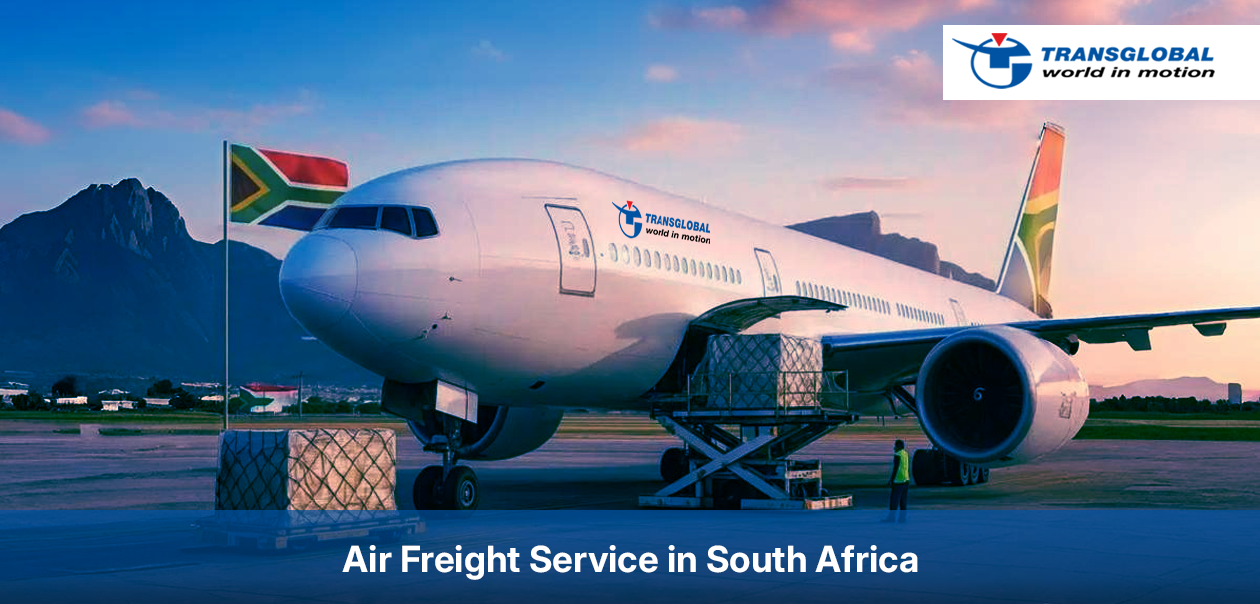The importers and exporters of South Africa are on a precarious edge. A surge in U.S. orders can empty warehouses overnight, while a mining breakdown in the Northern Cape can result in millions of rands in revenue by lunch. The air freight service transforms “too late” into “in time” when days, not weeks, determine profit or penalty. It does this by loading cargo into scheduled or charter aircraft departing from Johannesburg (O. R. Tambo), Cape Town, and Durban, and shipping it all over the world in 12 to 72 hours.
Speed, though, is only half the story. Every airborne kilo must clear safety checks, security screening, and customs paperwork before the wheels leave the runway. That’s where an experienced forwarder makes the difference: Transglobal Cargo blends sharp buying power with aviation-grade compliance, giving you three service choices, Red-Hot, Consolidated, and Deferred, all tracked in real-time by the TransIT portal. Below, you’ll learn what air freight really is, how the process flows through South Africa’s airports, and why a “flying start” begins long before take-off.
Air Freight in a Nutshell
Air freight is the door-to-door movement of cargo on passenger or all-cargo aircraft. Pallets are secured in Unit Load Devices (ULDs) or strapped directly to the aircraft floor, then flown to the closest hub, cleared by customs, and forwarded to final customers, often within 12–72 hours door-to-door. Because flights are frequent and routings are flexible, shippers slash lead times, cut emergency inventory, and shrink cash tied up in stock.
Why Air Freight Moves Faster?
- Direct lift: Scheduled wide-body flights depart daily on major trade lanes, and specialist freighters handle oversized loads.
- Priority handling: Airport cargo terminals break and make ULDs in a matter of hours, not days.
- Electronic documentation: e-airwaybills and advance manifest let SARS pre-clear shipments before touchdown.
- Smaller risk window: Less time in transit means fewer touch points and lower theft or damage exposure.
Choose the Right Service Levels for Smarter Air Freight
Transglobal blocks capacity with Emirates, Qatar, SAA Cargo, and fast-growing Dube freighters, so even Red-Hot slots come in at contract, not panic-buy, rates.
What Makes Air Freight Safe, Secure, and Ready to Fly?
Planes share airspace with passengers, high-value goods, and dangerous goods alike, so the health and safety bar is high:
IATA & SACAA rules ensure DG declarations, lithium-battery tests, and weight/size limits prevent in-flight hazards.
Regulated-agent security screens every piece by X-ray or ETD and seals ULDs to deter tampering.
Customs e-filings lodge airway bills and manifests with SARS pre-departure, slashing airport dwell time.
Cold-chain & special-cargo SOPs mandate temperature logs, shock indicators, and restraining nets for fragile, pharma, or live-animal consignments.
All-risk insurance & Montreal Convention liability cover the shipment from pickup to proof-of-delivery.
Transglobal’s IATA-trained team signs off a single Ready-for-Carriage checklist, one green tick that unlocks every downstream gate.
A Flight-Eye View: Seven Steps From Factory to Consignee
- Quote & Booking – You pick a service tier, rates include fuel surcharges and security fees.
- Pickup & Screening – Transglobal’s truck collects and then screens cartons in a SACAA-approved facility.
- Export Customs – A SAD 500 is lodged, and any doc tweaks can still be made on the spot.
- Airline Handover – Cargo is weighed, ULD-built, sealed, and released as “Ready for Carriage.”
- Flight & Tracking – The TransIT portal pushes ETD, airborne status, and revised ETA to your inbox or ERP.
- Arrival & Clearance – Ground handlers break the ULD, and routine freight can clear within two hours of touchdown.
- Final-mile Delivery – A bonded truck heads to Gauteng, KZN, or the Northern Cape, and POD uploads to close the job.
How Transglobal Saves Hours Off the Clock?
- Late cut-offs & weekend ops: Accept freight up to 16:00 for overnight flights, Saturday clearances are handled as standard.
- Smart packaging: In-house thermal blankets, UN-approved DG drums, and foam-in-place inserts eliminate last-minute repack fees.
- Port-switch agility: If Cape Town’s wind halts cranes, pallets rail overnight to Johannesburg and still catch EU flights.
- TransIT live data: Real-time milestones flow into dashboards, letting branch managers track by SKU or cost center.
- Dedicated claims desk: One team handles airline and insurer paperwork, freeing you to keep customers happy.
Smart Shipping Starts Before Takeoff: Plan, Prioritize, and Pre-Alert
- Know your commodity code early. Lithium batteries, biotech samples, and perishables each need special documentation and are declared upfront for hassle-free loading.
- Match the service tier to true urgency. Use Red-Hot for line-down emergencies, Consolidated for ongoing supply, and Deferred for price-sensitive replenishment.
- Alert the consignee. Half-day delays at the destination can erase the speed you just bought. Share ETA, HAWB, and duty estimates before take-off.
Conclusion
Air freight is the adrenaline shot of global trade, powerful, precise, and transformative when handled by a specialist. South Africa’s airports offer deep carrier schedules, electronic customs, and expanding freighter fleets, but only a forwarder who masters compliance, packaging, and real-time data can turn that infrastructure into on-time deliveries.
With IATA-certified teams, block-space deals, and TransIT visibility, Transglobal Cargo converts “air panic” into business as usual. Ready to fly faster, spend smarter, and keep customers smiling? Let’s build your next flight plan today.
Frequently Asked Questions
How quickly can Red-Hot cargo leave South Africa?
With paperwork in order by midday, Transglobal can truck freight to O. R. Tambo, clear exports, and catch an evening jet—often landing in Europe or the Gulf the next morning.
What documents do I need for lithium-battery shipments?
UN 38.3 test reports, an MSDS, and accurate watt-hour ratings. Transglobal files the Dangerous-Goods declaration, repackages it to IATA Section II or IA/IB if needed, and labels it so the airline accepts it the first time.
Can different branches track their air imports?
Yes. The TransIT portal issues sub-logins per branch while the head office sees a consolidated dashboard, ideal for shared inventory oversight.





Comments